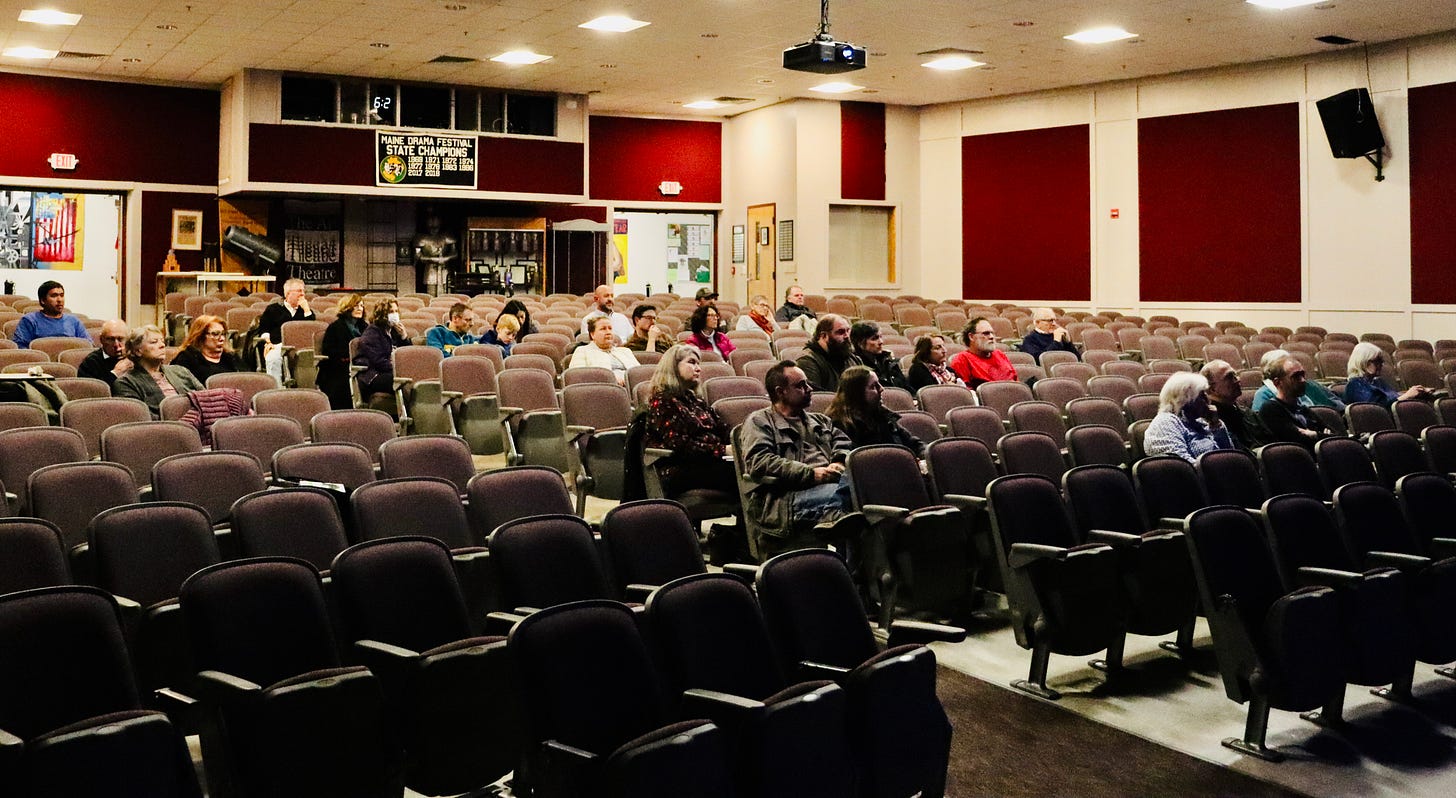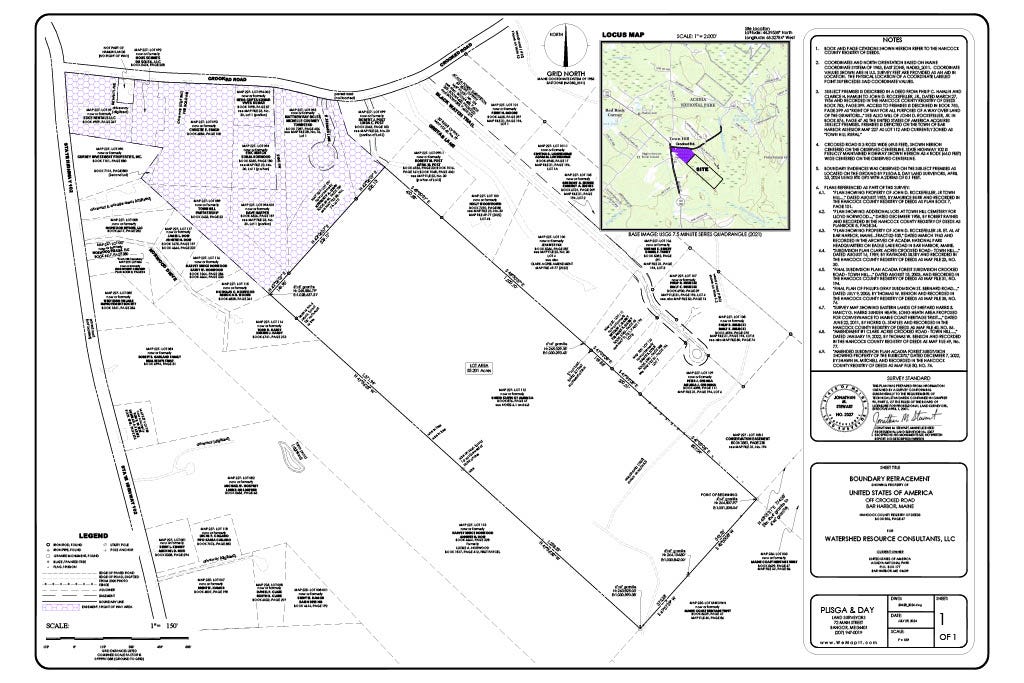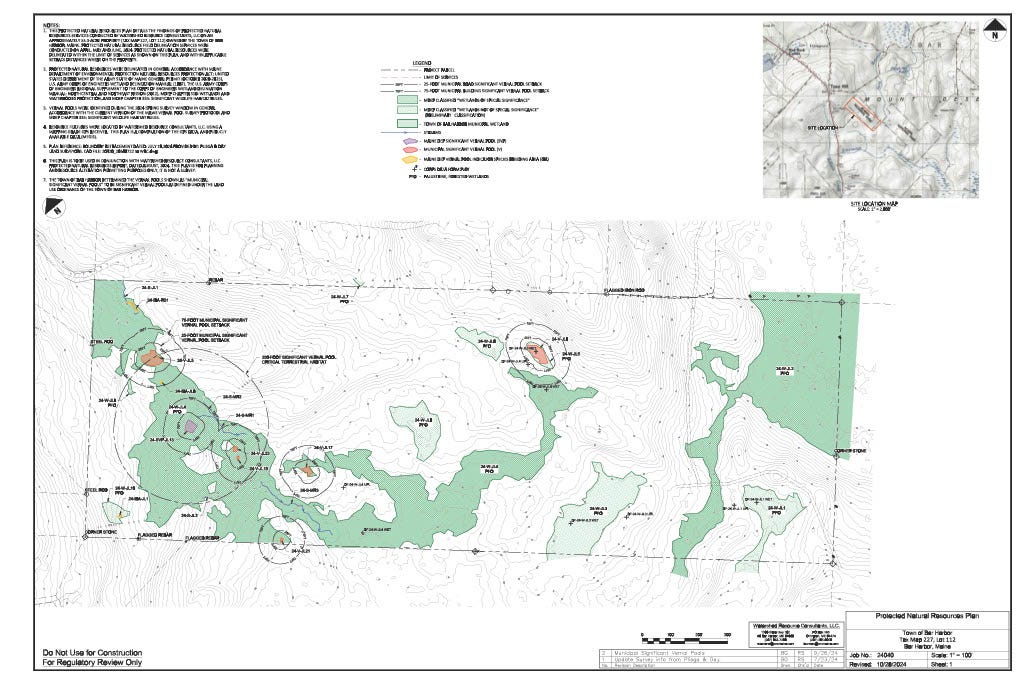Town Hill Housing Project Inching Forward
Two-thirds of Acadia's workforce can't afford to buy a home within hour of park
The Bar Harbor Story is generously sponsored by Window Panes Home and Garden.
TOWN HILL—Within the last six months, Acadia National Park (ANP) conducted a survey that showed that two-thirds of its year-round workforce can’t afford to buy a home within an hour’s drive of the park. This issue is shared by many employers and employees who are potential tenants and homeowners on Mount Desert Island.
One tiny step towards remediating this very large conundrum might be a landlocked 55-acre parcel of land in Town Hill. The 55-acre parcel is owned and managed by the park service but is not a part of ANP.
In July 2022, Maine Senators Angus King (I) and Susan Collins (R) introduced legislation that would allow a 55.3-acre undeveloped parcel in ANP to be converted into affordable housing for year-round and seasonal workers. That legislation passed in December 2022. The Island Housing Trust was a supporter of the bill.
A statement from Angus King’s office at the time stipulated, “If passed, this legislation would direct the NPS to work with the towns and other stakeholders on MDI to develop a plan to use the Town Hill parcel for affordable year-round and seasonal employee housing.”
On Tuesday, December 10, in the Higgins-Demas Theater at MDI High School, the Town of Bar Harbor and ANP jointly presented some history of the parcel and an update on what has been accomplished so far to make the concept a reality. An audience of approximately 30 people, mostly Town Hill residents and direct abutters to the parcel, were in attendance.
Acadia National Park Superintendent Kevin Schneider opened the presentation and said that every year ANP wants to hire approximately 175 summer seasonals but can only hire 115 due to housing restraints.
In regard to that recent survey, Schneider said, “That permanent workforce need is how we see this Town Hill parcel playing in, at least for the portion that we will retain for our year-round workforce. These are critical issues for all of our institutions.”
Bar Harbor Housing and Community Planner Cali Martinez and Acadia National Park Management Assistant John Kelly presented the bulk of the material and started off by stating that at this point in time there are still more questions and unknowns then there are answers.
HISTORY OF THE PARCEL
In 1960, John D. Rockefeller gifted the parcel to the National Park Service. The parcel was not contiguous to other ANP lands.
In the 1980s, concerns began to grow in regard to how big ANP was going to get and how much land in Hancock County it was going to absorb as part of park service lands. In 1986, a federal park boundary act was passed. This legislation set a legislated boundary for the park. This parcel was not within the legislated boundary of the park and the legislation allowed the tract of land to be given to the town to use as a solid waste transfer station. Other parcels outside of the boundary were transferred to other entities and deleted from ownership of the park.
The solid waste transfer station never materialized and the park maintained ownership of the land. The 2022 push to modify that legislation transferred that piece of land to the Town of Bar Harbor specifically to develop affordable workforce housing on the land and allowed the park to keep 15 acres for housing.
“The dedicated staff who work at Acadia National Park and in the hospitality industry in the surrounding towns make it possible for millions of visitors to enjoy the stunning natural beauty of Mount Desert Island each year. Unfortunately, a lack of affordable housing has contributed to workforce shortages and created significant hardships for employees who need to live nearby,” Senator Collins said in July 2022.
In April 2024, the Bar Harbor Town Council authorized transferring $24,768 from the town manager department budget to the planning department’s budget to proceed with studies about the feasibility of the Town Hill site for a workforce housing project. The total cost was estimated to be $34,400. Friends of Acadia paid Acadia National Park’s 28 percent of the total.
At the December 10 meeting, Martinez announced that the Town of Bar Harbor has been conditionally awarded a $50,000 grant from the Department of Economic and Community Development to help with the costs of further planning, analysis, and development in regard to the parcel and the best use potential for housing.
THE LAND, ACCESS, AND ENVIRONMENTAL CONCERNS
The parcel is 55.201 acres situated between the Crooked Road and Route 102. It is bordered by privately owned residential and commercial land on three sides, with a small section of one of those three sides being a conservation easement, and Maine Coast Heritage conservation land on the remaining side.
There is currently no road into the property but the property deed does contain a deeded right of way from Rockefeller. According to Kelly, the deed reads something to the effect of a right-of-way for all purposes over the land from a road running from Town Hill to Bar Harbor (now the Crooked Road) to the parcel. The deed does not specify where the right-of-way would be or the width of the right-of-way.
The Island Housing Trust (IHT) has recently purchased one of two properties that abut the parcel and the Crooked Road. The tentative plan is to put the right of way across the IHT property as it is conveniently located for access to what has been identified as potentially developable land.
The primary objective of Tuesday’s meeting was to engage neighbors, abutters, and community members, now that some preliminary analysis work has been done, before moving forward with the project.
A protected natural resource study has been conducted and that study found seven vernal pools with one being rated as a significant vernal pool. Significant vernal pools have a protected radius of 250 feet while non-significant vernal pools have a protected radius of 75 feet. The photo above shows the vernal pools and wetland areas as well as a couple of vernal pool species breeding area indicators.
The photo above shows possible solutions to some of the hurdles of the project. As Martinez and Kelly reiterated multiple times in the presentation, it is very early in the planning stages and all of these ideas are theoretically possible but none are set in stone and are very dependent upon further study and analysis of the property and negotiations between the involved parties.
The solid red line shows the property that could potentially be utilized to satisfy the nonspecific deeded right-of-way. However, the dotted red line shows the parcel that is now owned by IHT, which would most likely be the easiest way to go, is fairly direct, and allows the road to skirt the significant vernal pool. The 250’ protected radius of that vernal pool is the green/blue circle.
The dotted black line shows the land that has been mapped out as the most likely plot of buildable land. No information regarding how much acreage this plot encompasses was available at the time of the presentation.
AUDIENCE QUESTIONS
Nearby resident Bob Garland asked, “Will that parcel require a second means of access?”
In response, Planning Director Michele Gagnon said that the LUO does require subdivisions, as a standard, to have two means of access, but in the past few years this has been modified upon approval of the fire chief for a number of subdivisions. Gagnon said that she cannot say for sure what would happen but the subdivision may seek a modification for that standard.
Kim Zdenek, who lives on Black Watch Trail but is not a direct abutter asked if there would be an environmental impact study (EIS) done and if so, if it would take into account the 200-acre plot that is a bit farther down the road and consider the cumulative impacts of the full project?
Kelly responded that an EIS is the fullest assessment that you can be done and the park has not determined if they need to reach that level or if other forms of environmental impact studies will suffice. That process, Kelly said, would be determined by potential impacts and the existence of controversial environmental issues.
Along those environmental issue lines, Black Watch Trail resident and direct abutter Bill Garry wondered if anyone has contacted the Maine Environmental Protection Agency because of protected plants and animals. Both Martinez and Kelly said that the park service and town have not been in direct contact with the state but the consultants that were hired, Watershed Resource Consultants, LLC, have been in contact with multiple state agencies. They also said that further analysis, such as the presence of protected species, will be needed as things progress.
Direct abutter Jennifer Fisk said, “I have yet to hear anyone define affordable housing.”
“The wording comes from legislation and there was a lot of discussion when that law was being developed whether Congress should define it. The consensus basically, and the way it came out, was to leave it undefined so that remains a local decision and has validity to address the need that is here,” Kelly said regarding the definition of affordable housing.
Martinez said that Bar Harbor has the need for all levels of housing but for this project, “we need to collaborate with the other towns of MDI to really help define what makes the most sense in this case and what makes the most sense for all of the island communities,” in terms of what affordable is.
Another audience member asked about the possibility of public access recreational trails being a part of the property.
Kelly responded that the park and the town have thought about trails and talked about other amenities, such as a picnic are or a second playground, to benefit the community as a whole and not just the development. There is potential to connect to existing nearby trails, Kelly added.
Jim Dow, whose wife’s family is the largest abutter in sheer length asked, “Are you going to have to do ordinance changes? Because right now the ordinances, I know for our property and I am assuming for that property in the area, are for one residence every square two acres.”
“Just to put it on the table, once the park identifies the 15 acres that’s retained by the NPS, it’s not subject to local planning board review or local ordinance,” said Kelly.
“For the town’s portion, we will abide by zoning, and I will say that we are not going to do anything for just one area. But we are talking about, in general, in our plan to help increase housing in Bar Harbor overall, to help redo the zoning to help allow more housing overall,” said Martinez. She adde that the planning department and town “would look at it in a more comprehensive manner.”
LINKS TO LEARN MORE
Protected Natural Resources Report
December 10 Presentation Slide Show
Wetland and Vernal Pool Site Plan
A NOTE FROM US
Hello!
This is Carrie and Shaun, again. When we started the Bar Harbor Story, one of our major tenets was that we provide high quality, unbiased news for everyone, for free. Why would we want to do this? Because we believe that everyone, regardless of financial means, deserves to be as informed as they choose to be and not have to pay for that privilege.
Not only does the Bar Harbor Story, provide local news in a way that keeps you informed, but it, and us, also embraces and promotes community and the good that is within it.
We are working very hard to get the news out there—for free—for everyone. Most media isn’t local. Most media has paywalls and is inundated with advertisements. We don’t. We aren’t.
Richard Stengel writing in The Atlantic said, "Paywalls create a two-tiered system: credible, fact-based information for people who are willing to pay for it, and murkier, less-reliable information for everyone else. Simply put, paywalls get in the way of informing the public, which is the mission of journalism.”
As a news source that is owned and staffed by locals, we make every attempt to gather all of the facts for our readers, information that might not be part of the main story and/or information that may not be known even to our towns’ officials, but is still just as important, if not more important, to the story.
As we continue our journey towards expansion of coverage area and what topics we cover, we are once again asking for your help. We are not asking for anything money related this time, although we always greatly appreciate that, but we are asking you to help spread the word about the Bar Harbor Story.
If you feel that the Bar Harbor Story is doing the job of providing high quality, unbiased news, then we ask that you tell everyone that you know that has access to the internet, via any type of device, about us. You can tell them personally and they can do a web search for Bar Harbor Story or you can send them this web address barharborstory.substack.com and it will introduce them to the Bar Harbor Story and all they will have to do on their own is hit the “Subscribe” button at the bottom of any article.
Thank you for helping us allow people to know that they can have free access to the local news.
Carrie and Shaun
THANK YOU FOR SUPPORTING OUR COMMITMENT TO YOUR COMMUNITY
If you’d like to donate to help support us, you can, but no pressure! Just click here (about how you can give) or here (a direct link), which is the same as the button below.
If you’d like to sponsor the Bar Harbor Story, you can! Learn more here.












